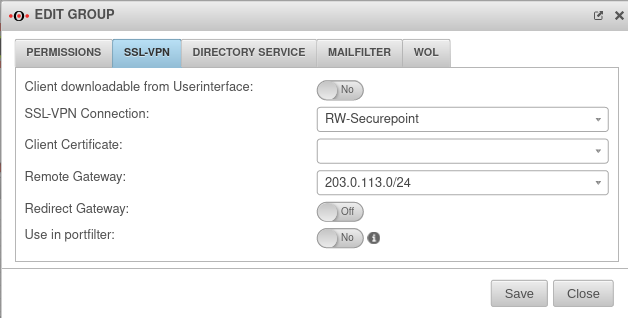notempty
notempty
notempty Dieser Artikel bezieht sich auf eine nicht mehr aktuelle Version!
notempty
Der Artikel für die neueste Version steht hier
Zu diesem Artikel gibt es bereits eine neuere Version, die sich allerdings auf eine Reseller-Preview bezieht
Create and configure groups (permissions) for SSL-VPN
Last adaptation to the version: 12.2.4
notempty
This article refers to a Resellerpreview
This is where to configure settings for the SSL VPN for an entire group.
All users share the same certificate when using the group settings!
SSL VPN settings of individual users override the group settings.
| Caption: | Value | Description: |  |
|---|---|---|---|
| Client downloadable in the user interface: | No | If enabled, the VPN client can be downloaded in the user interface | |
| SSL VPN connection: | RW-Securepoint | Select the preferred connection (created under ) | |
| Client certificate: | Select the certificate for this group (created under Tab Certificates) It is also possible to use ACME certificates.
| ||
| Remote Gateway: | 203.0.113.0/24 | IP address of the gateway on which the SSL VPN clients dial in. Free input or selection via drop-down menu. | |
| Redirect Gateway: | Off | Requests to destinations outside the local network (and thus also the VPN) are usually routed directly to the Internet by the VPN user's gateway. When the On button is activated, the local gateway is redirected to the UTM. This way, these packets also benefit from the protection of the UTM. This setting changes the configuration file for the VPN client.
| |
| Use in portfilter: | No | By enabling Yes this option, rules for this group can be created in the portfilter. This can be used to control access for users who are members of this group connected via SSL VPN. |